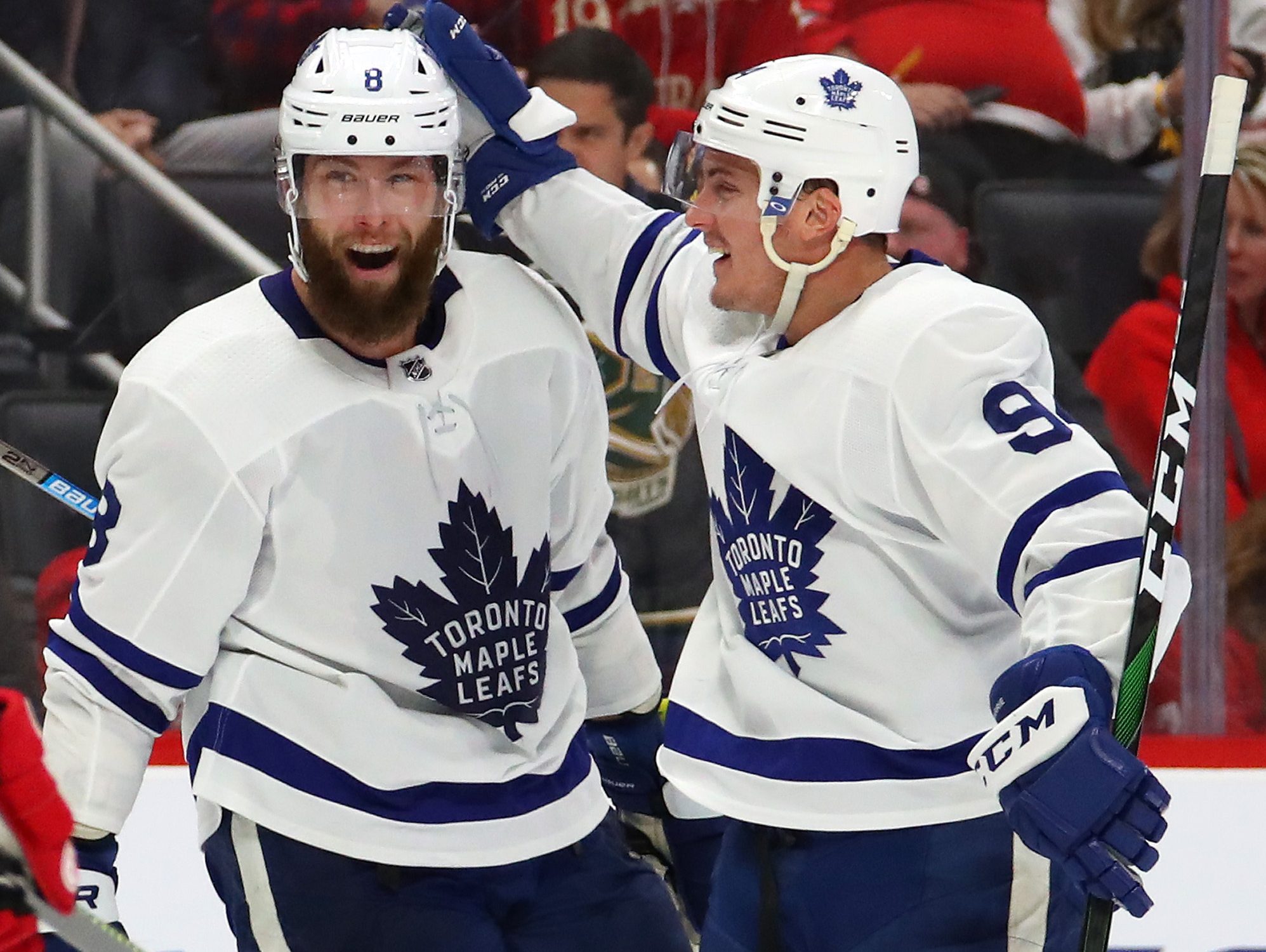There is little doubt that the Toronto Maple Leafs’ problems lie inside their own zone.
With all of the concerns and questions about the Leafs defense, let’s try to answer some of those questions by way of analysis as the trade deadline nears.
1. How much is Toronto tilted away from defense?
A lot.

Of all NHL teams, the Leafs are one of the most “bipolar,” ranking fourth in goals and 26th in goals against. But I don’t need to tell Leafs fans that.
The heat maps to the left give an idea of the spread between offense and defense — the Leafs cough up 5% more threats while scaring their opponents with an attack 11% above the average team.
That bottom rink map is the concern. It needs a deeper look so we can fully understand the Leafs situation before the deadline on February 24th.
Injuries to key defensemen have also contributed to the tilt.
- Travis Dermott missed the first 14 games due to recovery from shoulder surgery.
- A December 27th broken foot kept Jake Muzzin out for one month.
- A fractured foot on January 12th is expected to keep Morgan Rielly out a minimum of eight weeks.
- And to cap it all off, Cody Ceci suffered an ankle injury on February 12th and is scheduled to be reassessed in one month.
All of that will exceed 65 man-games.
It would be wrong to lean on injuries as an excuse, but it would be equally wrong to ignore the impact they have had in weakening the Leafs in their own zone. Rielly, Muzzin, and Ceci were slotted in the top four on opening night.
Imagine a siege on a castle…
Captain: “They haven’t got a great defense. Not much depth, either. We might be able to weaken them further by taking out three or four of their top defenders. Not all at the same time — just keep them juggling and under pressure.”
General: “That should work.”
2. Has the defense improved under Sheldon Keefe?
When Sheldon Keefe took over on November 20th, he inherited a team that was treading water — a team with a dramatic drop in offense, a fragile defense, sputtering special teams, and inconsistent goaltending (I wrote about Babcock’s Leafs the day before he was fired and laid out the facts I had at the time).
Although there was a lot of focus on the Rielly – Ceci pair’s defensive troubles, it was apparent to me that the Jake Muzzin – Tyson Barrie pair was off to a rocky start.
“Most are aware of Barrie’s history of defensive issues but expected a strong offensive showing to counteract them. Right now, he is well below average on the xGF/60 RAPM. That is worth monitoring.”
Sheldon Keefe has mobilized the defense in a different way, allowing them to rotate and move into the offensive zone and feeding more passes to a center-high forward in the zone. This increases zone time, but at the same time, it leads to more rush chances against. In the defensive zone, more of a “protect the house” approach was stressed with a less aggressive defense against perimeter forwards. More can be found in this MLHS article.
A change in the role of defensemen at both ends of the rink means we should start by looking at a two-way metric: expected goal share. I wrote about Keefe’s early impact on two-way play after only three games because the shift in numbers was so significant. There still is a dramatic difference as we can see here:

Seriously, give Sheldon Keefe his due. He’s made a difference.
The Muzzin – Holl pair, Tyson Barrie, and Travis Dermott have all had much better on-ice expected goal shares under Keefe. (Note that on-ice statistics like these are also affected by the other players on the ice, including the forwards, but it still gives insight on what is happening with a defenseman when he steps on the ice. Results for players like Marincin, Sandin, and Liljegren are based on small game samples, so don’t read too much into them.)
Has xGF% declined?
No.
One question I had was whether recent games have shown a softening in the xGF% trend under Keefe. I took a look and all I see is a fairly stable level since the coaching change, although the Tuesday game in Pittsburgh is apparent.

3. What about the defensive zone under Sheldon Keefe?
Mixed. But what did you expect with those injuries?
While Keefe’s new approach to the offensive zone attack has boosted xGF%, the same isn’t quite as clear in the defensive zone when we look at expected goals against per 60 minutes (xGA/60). Note that higher numbers in this chart mean more expected goals against, so the lower bars are the best. (Try not to stare at Timothy Liljegren’s bar; it’s a small sample and he’s a rookie. Besides, I like him.)

If we focus on the top-minute defensemen, we can see that Muzzin and Ceci both improved post-Babcock (when healthy), while Barrie and Rielly both lost ground defensively (e.g. Morgan Rielly went from 2.32 to 2.61 xGA/60 before he was injured).
This, in a nutshell, is the challenge the Leafs have: to maintain an aggressive offense while protecting Rielly and Barrie from excessive counterattacks. Overall, the strategy has appeared to work because the net impact (expected goal share) has improved for both of them. But we need to keep in mind that Toronto’s forwards provide a layer of support for those xGF% on-ice numbers.
Has xGA/60 worsened?
There is some evidence that it has worsened (i.e. went higher on the chart) once the Muzzin/Rielly/Ceci injuries took hold around the start of the year.

While two-way expected goal shares have improved and stayed there, there are more mixed results and weakening in the defensive zone where expected goals against have shown some strain, despite improved results for Jake Muzzin in particular.
4. What do the advanced stats say about the defensemen?
Individual advanced player estimates are not available by split for Babcock and Keefe. We will continue by looking at the entire season, knowing that Keefe has now coached for three full months (the bulk of the Leafs season so far).
Are the Leafs weak at allowing cross-slot and other high-danger passes?
No. They are average.
I asked Corey Sznajder (@Shutdownline) this question. Corey has built up a remarkable database of manually tracked passing and zone exit/entry data. His data shows that high danger passing plays in the Leafs zone – cross-slot (4.4%) and passes from behind the goal line (4.3%) are average this season. Corey doesn’t have enough games tracked to comment on results under Keefe. You can help support Corey’s efforts through his Patreon.
Who faces the toughest competition?
One area that is often overlooked is the level of competition a defenseman faces. I believe it says a lot about the coach’s trust in a defenseman, especially in the defensive zone. One statistic I use in SKATR is “TOI% vs Elite” (forwards).
Plan A had been to have Rielly and Ceci face the toughest competition and give Barrie a little sheltering next to Jake Muzzin. Ceci’s difficulties when inserted too high in the lineup torpedoed that idea. Keefe then tried Rielly – Barrie, but Rielly went down injured.
This pecking order gives you an idea of how the defensemen rank and who is being heavily sheltered. In retrospect, Barrie should have been sheltered more but injuries have forced him higher than he should be defensively. The one positive out of this is the ability of Justin Holl to be trusted to play higher. At times, he may look overmatched, but on the whole, he has been solid.
We also need to be a little careful interpreting the play and numbers of rookies Sandin and Liljegren given that they spend a lot more of their time sheltered from elite forward lines.

Who is performing best at even-strength?
I see “Plus-Minus” a lot in conversations about defensemen.
Plus-Minus would be useful if it wasn’t such a terrible stat.
Wouldn’t it be better to remove the goalie from the mishmash and adjust for each players’ teammates and competition on the ice? After all, no one believes you when you say Ron Hainsey was the seventh-best defenseman on the planet last year because he had a +30 plus-minus surrounded by Norris, Vezina, and Rocket Richard candidates.
There’s a way to fix it though: RAPM — “Regularized Adjusted Plus Minus” — adjusts for the players on the ice and attempts to isolate the part of +/- that is due to a player. Evolving-Hockey went to a lot of effort to build models at the “stint” level — the part of a shift where a player is on with a certain set of other players. More on RAPM methodology can be found here.
There is an “xG” version of RAPM that excludes the effects of goalies. That’s the one we need to help separate goaltending from defense.
I constructed the dashboard below so that we could focus on the Even-Strength RAPM version of xG plus/minus (+/-) per 60. The scatterplot on the left shows how the Leafs defensemen perform on offense (RAPM xGF/60) and defense (RAPM xGA/60). The size of the circles show their total minutes played at even-strength; the colour progresses from red to blue as their xG +/- per 60 improves.
The chart on the right of the dashboard ranks them by their total xG +/- per 60. I included Marincin, Sandin, and Liljegren out of interest, but they have had limited minutes, so their estimates will likely bounce around with more playing time.

Key RAPM Takeaways
- As a result of key injuries, Tyson Barrie has played the most minutes on the team despite having one of the worst xGA/60’s. His offense does not make up for his defense. This has been a perfect storm as far as exposing him more to top forwards and weakening the defense.
- Morgan Rielly (though apparently injured all season) cannot be depended upon to suppress expected goals against but has a mostly neutral impact once you add in his superior even-strength offense.
- Jake Muzzin and Justin Holl are the “beauts” on this chart, maintaining a level of defense while supporting the offense. Their xG RAPM’s lead the team, but they are under the strain of heavy, tough minutes.
- Travis Dermott’s visible offensive contributions have fallen off, but his defense in a lower role has been a definite “plus”. In theory, he should be capable of handling a second pair role on the left side in Rielly’s absence.
- Cody Ceci has done better on the defensive side than on offense, but he still nets out with the second-worst RAPM of the regular top 6 (-.03/60). He leads the team in the suppression of expected goals against, while his offense is the weakest. Ceci has also seen his ice time drop as the season progresses having started with a steady diet of top competition beside Rielly.
- The low minute defensemen are led by Martin Marincin. Despite his shortcomings with the puck and glaring mistakes at times, he has experience, can break up zone entries and passes with a long stick, and he has contributed defensively, leading to a positive RAPM on the season (+.09).
- Rookie Rasmus Sandin has now played 22 games and has shown flashes of offensive promise and poise in his own end, but his overall defensive side may take time to develop, like any 19-year-old rookie in the NHL.
- Having played very few minutes, it’s completely unfair to judge rookie Timothy Liljegren, but at this point, in a limited role, he is a liability with a -.10 xG+/- per 60. He still has a lot to learn. Fans usually expect too much of a 20-year-old defenseman. It takes time.
5. Where does all of this leave the Leafs?
After a see-saw home-and-home series with the Penguins, we got a good chance to see the Jekyll and Hyde nature of the Leafs team right now. One area I have not covered is goaltending. Last night, team defense and solid goaltending led to an impressive shutout. Subpar goaltending can make a defense look bad and vice versa. Both have been happening this season.
The Leafs goaltending has been an issue, with Frederik Andersen allowing an estimated 15 goals more than expected given the chances he has faced. That works out to roughly eight points in the standings, so it is significant. Expected goal models don’t cover everything — such as a Crosby cross-slot pass to a wide-open Jason Zucker — but over a season, they should give a better indication than save percentage.
The point I am trying to make: Despite all the trials and tribulations, the Leafs defense is not as bad as some suggest because the goaltending has amplified the results. But it’s still a definite weakness that needs to be addressed, as the RAPM results point out.
The left side is hurting in the absence of Morgan Rielly. Reports suggest that Jake Muzzin will be signing a four-year extension soon (probably on March 1st for cap-tagging reasons). With Travis Dermott showing good RAPM results and Rasmus Sandin developing, the Leafs look solid on the left once Rielly returns.
The right side is another matter. Justin Holl is found money and has propped up the right side based on these RAPM numbers and the eye test. After that, things get dicey. Although Tyson Barrie is keeping the power play rolling and has elite offensive skills, he is still a serious problem in his own end and needs to be sheltered. After that, there’s a marginal injured defenseman in Cody Ceci and an inexperienced rookie thrust into battle.
The Leafs need a top-four RD solution — not just now while Ceci is injured, but longer term.
If so many picks had not been spent elsewhere, I would have been satisfied with an RD rental-for-pick as I covered in an earlier piece, where I zeroed in on the now-traded Dylan DeMelo.
As it stands, the reported discussions at this point seem to revolve around right-shot defensemen like Sami Vatanen, Matt Dumba, or Risto Ristolainen. I’ve covered these defensemen in previous MLHS articles. None of them stand out as good solutions for the Leafs defensive zone (especially Dumba). A player like Josh Manson is the right solution, but at this stage, I highly, highly doubt he is available at anything other than a Godfather price.
There are three days until the trade deadline. Given everything, I would not be surprised if Kyle Dubas chooses to hold off until the off-season when more options are available.
Right now, there is a hole on the right side and we all have plenty of ideas for filling it. But the repair may be costly and take time to fix. We’ll know more by Monday at 3 p.m. EST.


































